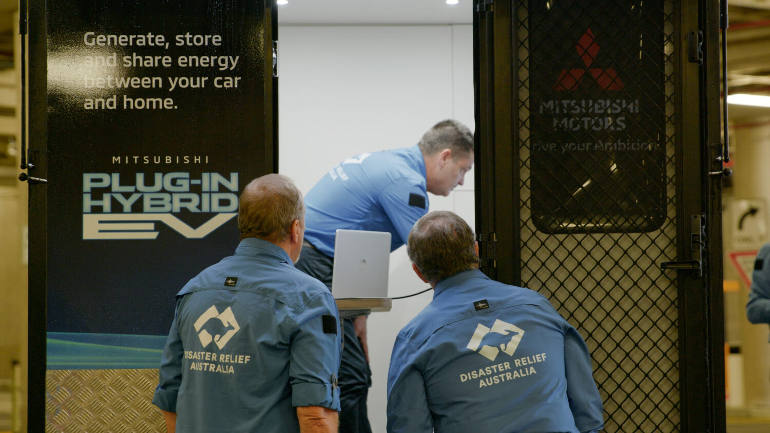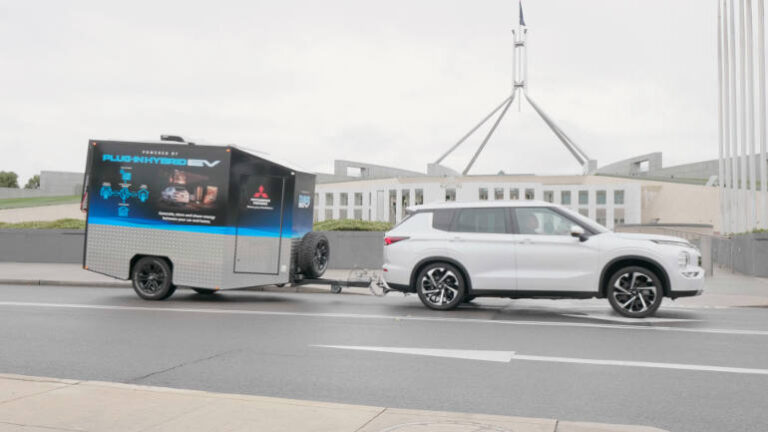Disaster Relief Australia (DRA) and Mitsubishi Motors Australia Limited (Mitsubishi Motors) have joined forces to deliver improved technological capabilities for DRA’s disaster response work.
In recent years, local government Fleet Managers have been called upon to provide mobile assets when floods and fires strike their communities. The V2L and V2G capabilities of EVs and PHEVs provide another tool to respond quickly when disaster strikes.
The technology was demonstrated at Parliament House recently by Minister for Emergency Management, Senator the Hon Murray Watt, and showcased Mitsubishi Motors’ prototype bi-directional charging technology, particularly its application in rural and remote Australian communities affected by disasters, when DRA’s Disaster Relief Teams require a solution to power their ‘hubs’ on the ground.
The trailer brings together vehicle-to-grid technology enabling plug-in electric vehicles to power essential equipment in rural and remote areas even when the power grid fails. This means food and vital medicines can stay refrigerated, cooling and heating systems can operate, and water treatment plants and communications systems can stay running, ensuring everyday Australians are more resilient during bushfires and other natural disasters.
Mitsubishi Motors and DRA commenced their partnership in 2019, with the aim of supporting DRA’s expansion to deliver much needed disaster relief to communities across Australia.
Both DRA and Mitsubishi Motors are deeply committed to supporting Australian communities affected by natural disasters and acknowledge the Australian Government for $38.1 million in funding to support DRA’s disaster relief efforts.
DRA’s ability to deploy this technological solution is particularly critical now, following the release of the Defence Strategic Review in April 2023, imploring the Government to pursue civilian responses to emergency management and relief, rather than continuing the overreliance on the Australian Defence Force for domestic crisis response work.
DRA’s volunteer base is filled with returning service men and women, emergency services personnel, and motivated civilians. Their invaluable experience and record of service is extended through deployments with DRA.
Given the bushfires already rampaging across parts of the country, and the warnings from meteorologists that this summer is expecting to see further disasters impacting Australian communities, there has never been a more important time to focus on the efforts to support them in their time of need.

Senator the Hon Murray Watt, Federal Minister for Emergency Management said, “The Albanese Government is deeply committed to disaster preparedness, recovery and resilience, and Disaster Relief Australia plays an important role in helping communities right across the country get back on their feet.”
“The DRA hubs have become a symbol of recovery and reassurance for regions after a bushfire, flood or storm, so we welcome this new technology.”
Geoff Evans, Chief Executive Officer of DRA said, “The technology showcased at Parliament House has great potential to be used by communities and DRA to increase power accessible to Australians during times of crisis or natural disasters.”
“DRA has been proud to increase our capacity and capability to respond to natural disasters year on year and are grateful for the support of our corporate partners and State and Federal Governments to continue aiding Australians in need.”
Shaun Westcott, Chief Executive Officer of Mitsubishi Motors said, “We are excited to showcase this cutting-edge and world-leading technology in partnership with Disaster Relief Australia, and continue highlighting Mitsubishi’s powerhouse innovation used to benefit Australian communities.”
“Bi-directional charging capabilities have the potential to revolutionise the way in which we can manage the major impacts of natural disasters and increase resilience through integration into Australia’s energy infrastructure.”
Mitsubishi Motors’s bi-directional charging technology is currently available internationally, and its ability to actively support reducing transport emissions integration into the Australian grid for energy storage.







